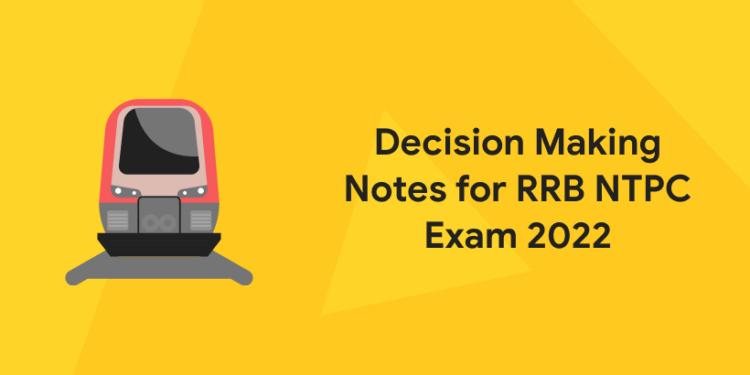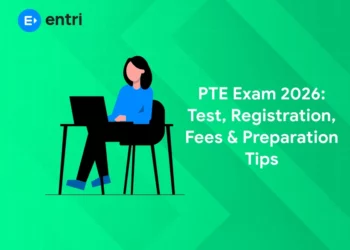Table of Contents
The RRB NTPC test is used to hire applicants for posts in the Non-Technical Popular Categories, which include employment such as Assistant Station Master, Traffic Assistant, Commercial Apprentice, Traffic Apprentice, Goods Guard, and so on. The RRB NTPC exam is one of the most popular railway tests in the country since it offers fantastic career opportunities. The RRB NTPC exam consists of a first-stage computer-based test (CBT), a second-stage CBT, a typing skill test/computer-based aptitude test (where applicable), and a document verification/medical examination. Candidates must prepare well for the RRB NTPC exam. Candidates must put in their best efforts and work attentively to gain employment in the Indian Railways.
Click here to know the detailed syllabus of the RRB NTPC 2022 exam
RRB NTPC CBT 1 Exam Pattern 2022
The following is a full outline of the RRB NTPC CBT -1 exams:
| Sections | Maximum Marks |
| General Awareness | 40 |
| Mathematics | 30 |
| General Intelligence and Reasoning | 30 |
| Total | 100 |
| No of Questions – 100 | Time – 90 Minutes |
Click here to know the weightage details of the RRB NTPC 2022 exam
RRB NTPC CBT 2 Exam Pattern 2022
1: The electron was discovered by________.
The recruitment exam will be conducted at testing centres around the country using a computer-based test. The exam will consist of 120 multiple-choice questions, each earning one mark. The NTPC Computer Based Test – 2 will last 90 minutes. one hour and thirty minutes Each component will consist of 35 MCQs from Mathematics, General Intelligence, and Reasoning, with the remaining 50 questions from General Awareness. More details regarding the RRB NTPC CBT-2 Exam Pattern 2022 may be seen in the table below.
| No. | Subject | Questions asked | Marks allotted |
| 1. | General Intelligence & Reasoning | 35 | 35 |
| 2. | Mathematics | 35 | 35 |
| 3. | General Awareness | 50 | 50 |
| Total | 150 | 150 | |
Register to learn more about railway exams
RRB NTPC General Intelligence & Reasoning Syllabus 2022
In this part, we shall go through the RRB NTPC 2022 curriculum for general intellect and reasoning.
- Data Sufficiency
- Completion of Number & Alphabetical Series
- Jumbling
- Mathematical Operations
- Interpretation of Graphs
- Relationships
- Venn Diagrams
- Syllogism
- Statement – Conclusion
- Maps
- Analogies
- Puzzle
- Statement – Courses of Action
- Similarities & Differences
- Coding & Decoding
- Analytical Reasoning
- Decision Making
Register to get free study sources for RRB NTPC Exam 2022
Decision Making Notes for RRB NTPC Exam 2022
A decision Making is a procedure that results in a final result after analysing the provided data. As a selection criterion, a collection of rules is provided. It is followed by the candidate’s qualification. Two requirements must be met throughout the selection phase, and they are as follows:
- Primary Condition
- Additional condition
Questions in decision making include the following:
- Details about a candidate.
- There are several requirements that an applicant must meet to be considered for a specific job or position.
- When a candidate meets all but a few of the requirements, a new course of action must be adopted for him or her.
Register to see video classes for the numerical ability for the RRB NTPC exam 2022
Decision Making: Primary Conditions and Additional Conditions
In this sort of question, there are some parameters that an applicant must meet to be considered for a specific position. These are known as Original or Primary conditions. Similarly, there are additional criteria in similar cases. We’ll refer to these as “additional conditions.” A little bit of reasoning is required to answer this kind of question. To make the proper pick, all you have to do is look to see whether the applicant meets some of the criteria. An approach is proposed below that takes into consideration several aspects of this situation. These sorts of difficulties may be readily handled by creating a table with the information provided.
Register to see video classes for QA for the RRB NTPC exam 2022
Decision Making: Solving Method
- Mark primary conditions as a, b, c, d etc.
- Mark additional responses as 1, 2, 3, 4 etc.
- Write them in the top row of the table.
- Then, in the table’s extreme left column, put the question number and the names of the candidates. Put the primary conditions without brackets and the secondary circumstances in round brackets.
- Again, write the signs of additional conditions with an oblique (/) mark next to the sign representing the primary condition with which these may be associated. If we have five questions, four primary conditions, and two additional conditions, we must create the table shown below.
| Question no. | a | b/ (1) | c/ (2) | f |
| 1 | ||||
| 2 | ||||
| 3 | ||||
| 4 | ||||
| 5 |
In this phase, carefully read each question and compare the facts provided with the various circumstances one by one. Put the suitable sign {‘✓’, or ‘×’ or ‘(✓)’ or ‘(×)’, as appropriate}.
- If the main condition is met, a tick mark should be placed beneath it.
- If a primary condition is broken, insert a cross mark next to it.
- If the main condition is violated but there are extra conditions associated with it, place a bracketed cross mark below it if the additional condition is also violated, and a bracketed tick mark below it if the additional condition is satisfied.
- If no information is provided, a ‘?’ mark should be placed beneath it.
The table below serves as an example.
| Question no. | a | b/ (1) | c/ (2) | f |
| 1 | ✓ | ✓ | ✓ | × |
| 2 | ✓ | ✓ | ✓ | ✓ |
| 3 | ✓ | (✓) | (✓) | ✓ |
| 4 | ✓ | ✓ | (×) | ✓ |
| 5 | ✓ | ? | ✓ | ✓ |
The above example demonstrates the following:
- The four major conditions are a, b, c, and d, whereas I and (ii) are two extra circumstances.
- Condition (1) is associated with b, whereas condition (2) is associated with c.
- In question (1), d is violated while a, b, and c are satisfied.
- All of the main conditions a, b, c, and d are fulfilled in question (2).
- The main conditions a and d are fulfilled in question (3), and even if the primary requirements b and c are violated, the supplementary conditions (1) and (2) are satisfied.
- In question (4), the primary conditions a, b, and d are fulfilled, yet both c and (2) are broken.
Now, choose your response based on the following rule.
- If you get a cross symbol, don’t bother looking at the following requirements. Select the preference applicant not chosen and proceed over to the next question.
- If there is no cross but a ‘?’ mark beneath any criterion, choose the choice data is insufficient.” This is referred to as data insufficiency.
- If no marks are available, carefully examine the response and determine which combination of factors leads to which conclusion, then create a combination chart.
Grab the latest modal question papers for RRB NTPC Exam 2022
Decision Making: Illustrative Examples
Examine the following information carefully and respond to the questions that follow. The following are the requirements for people to work as faculty members in a computer education centre. The applicant must:
- Be between the ages of 23 and 28 on November 1, 1993.
- Have prior employment or programming experience.
- Possess a postgraduate degree in computer science. i.e. MCA, M.Tech, etc. with at least 60% marks
- Score at least 25 points out of a possible 50 points in the interview.
If a candidate
- meets the aforementioned qualifications, he or she will be appointed as a senior faculty member.
- Has a postgraduate degree in computer application with less than 60% but greater than 50%, he/she should be employed as a junior faculty member.
- Is over the age of 28 but under the age of 32 as of November 1, 1993, in which case the matter may be submitted to the director of the centre.
Based on the aforementioned conditions and the information supplied, we must determine which of the following actions should be performed against each applicant. Don’t make any assumptions. Decisions will be made solely based on the information given. Choose the option:
- If the candidate is to be appointed as a junior faculty member.
- If the candidate is chosen as a senior faculty member.
- If the situation is to be forwarded to the centre’s director.
- If the data is insufficient.
- If the applicant is not chosen.
Details
- Manisha Punjabi has an M.Sc. in computer science with a grade point average of 65. Her birthday is July 31st, 1965. She has been working as a programmer in an institution for the past four years.
- Kishore Garg has a 61 per cent grade point average in MCA. His birthday is August 14, 1970. He has been a computer teacher for three years. In the interview, he received a score of 60%.
- Babli Sarkar has an M.Tech with a 58 per cent grade point average. Her birthday is December 31st, 1971. She has been a coder for the past two and a half years. She received 40 points in an interview.
- Manish Kumar holds an M.Sc. with a grade point average of 52%. His birthday is July 10, 1968. He has been a computer teacher for four years. In the interview, he received a 40% score.
- Sudha Ranjan earned an MCA with a grade point average of 56%. She has been a programmer for three years. Her birthday is February 12th, 1969. In the interview, she received a mark of 55%.
Solution: ‘a’, ‘b’, ‘c’, and ‘d’ are the four primary conditions, and ‘f’ and ‘g’ are two additional criteria. Read each question carefully and examine the information provided with the various criteria before selecting the proper answer.
| Question no. | a/ (g) | b | c/ (f) | d |
| 1 | (✓) | ✓ | ✓ | ? |
| 2 | ✓ | ✓ | ✓ | ✓ |
| 3 | (×) | ✓ | (✓) | ✓ |
| 4 | ✓ | ✓ | (✓) | × |
| 5 | ✓ | ✓ | (✓) | ✓ |
- Manisha is an M.Sc. student who has received a 65 per cent grade. This satisfies requirement c. Condition a is broken, even though she was 28 years old on July 31, 1993. The additional condition of an is g, which is why we inserted a ‘(✓)’ mark here. Manisha has worked in the industry for over two years. As a result, we put a ✓ mark next to condition b. The space may be seen below condition d. As a result, in the question, we refer to d. Because we don’t know what Manisha got in the interview, we put a ‘?’ there.
- Kishore Garg has a 61 per cent grade in MCA. It meets criteria c, therefore we added a ✓ mark next to it. He will be somewhat older than 23 years old, according to his birth date. As a result, it satisfies a. Below a, we inserted a ✓ He has more than three years of professional experience. As a result, it satisfies b. He received a 60 per cent in the interview, which meets d.
- Babli Sarkar has a 58 per cent on her M.Tech, hence she violates c. f is an extra condition that is tied to c. We can see that f is fulfilled by referring to f. As a result, we inserted a ‘(✓)’ mark over there. Her birth year is 1971, thus she is definitely under the age of 23. This is a violation of condition a. g is an extra condition tied to a, hence it is also broken. There is a (×) mark there.
- Manish has a 52 per cent M.Sc. grade. As a result, it contradicts c while also satisfying the extra requirement f associated with c. There is a (✓) mark there. He was born in 1968, making him almost 25 years old. As a result, an is fulfilled. Below a, we inserted a ✓ For four years, he worked as a computer teacher. As a result, condition b is satisfied. The percentage of marks gained during the interview is 40%. We put × a mark underneath d because it violates d.
- Sudha received a 56 per cent on her MCA exam. This fails criterion c but satisfies condition f. There is a (✓) mark there. She has three years of experience. It satisfies the b criterion. She is 24 years old, having been born in 1969. As a result, condition a is met. She received a grade of more than 50%. As a result, condition d is met.
Now we must select which set of criteria leads to which result, and the conditions are as follows.
| Criteria satisfied | Result |
| a + b + c + d | senior faculty member |
| g + b + c + d | to be referred to the director |
| a + b + f + d | junior faculty member |
The table below shows the results.
| Name | Result |
| Manisha | data inadequate |
| Kishore Garg | senior faculty member |
| Babli Sarkar | not selected |
| Manish | not selected |
| Sudha | junior faculty member |
Grab the latest mock test series for RRB NTPC exam 2022 for free
The article above has examined how to handle decision-making questions in an effective manner. You may answer the decision-making issues for RRB NTPC Exam 2022 by following the suggestions on this page. Constant practice will also aid in the improvement of your speed. Download the Entri app to practise more modal problems for RRB NTPC Exam 2022 decision making topic. The application provides detailed answers to all the questions given above.










